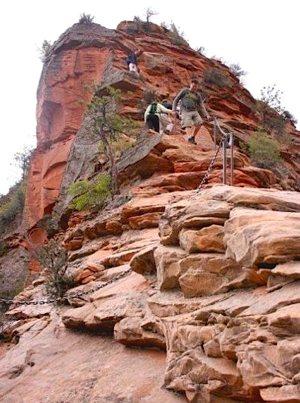What should the National Park Service do, if anything, with Angel's Landing in Zion National Park?
This question arises every time there's a fatality, and rightly so. The recent death of Barry Goldstein has rekindled the debate, with at least one reader believing the Park Service should, in essence, certify the ability of hikers determined to reach the landing.
Is that reasonable? Does the Park Service have the manpower to station someone at the base of the landing to bear that responsibility? Would it not merely heighten the Park Service's liability for those who are deemed experienced enough to make the hike to the top?
And if the Park Service agreed to such a proposition, which I doubt will ever happen, what of other parks and the risks they present? How do you guard against canoeists, kayakers and rafters drowning while on park outings? What about those who are swept away by avalanches, who are attacked by grizzlies, die from the heat at the bottom of the Grand Canyon, or fall from Half Dome in Yosemite?
What responsibility does the Park Service have to try to prevent these accidents? Just as important, if not more so, what responsibility do individuals bear?
We live in a dangerous world, one where we have to recognize not only the dangers that exist, but our own limits. And those who visit national parks need to appreciate that these are not city parks, not well-manicured and contained. National parks present a host of dangers, ranging from cliffs and rivers to wildlife and even other park visitors.
This is not intended to belittle or minimize the loss felt by Mr. Goldstein's family and friends, or the families and friends of other victims of national park accidents. It's not to question their actions, capabilities, or decision-making. The pain of their untimely deaths cannot be soothed, there is no salve that can erase it.
Rather, this post is simply to acknowledge that there are dangers that exist, both in national parks and beyond their borders, throughout the world we live in, and that we need to accept both the responsibility of our decisions and that accidents do happen.
Might those who fell from Angel's Landing over the years been saved had they had to meet specific qualifications to ascend to the summit or if the Park Service put railings atop the landing to keep hikers a safe distance from the edge? Perhaps. But incredibly qualified climbers have died in accidents in the parks, and folks have clambered over railings, trusting their own judgments, only to die in accidents.
Beyond that, do we really want to sanitize the parks?
I don't think I'm alone in believing that a good part of the allure of places such as Zion, Yellowstone, Yosemite, North Cascades, Mount Rainier and Grand Teton, just to name a half-dozen parks, is their ruggedness, their wildness, of entering them on our own terms and seeing how we match up.
It scared the hell out of me the first time I went up Angel's Landing, when I climbed to the top of the Grand Teton, and to the summit of Half Dome. That adrenalin rush not only heightened my cautiousness, but it also let me know how alive I was. When my time does arrive, I hope it comes in a national park and not while driving down the highway or crossing the street.


 Support Essential Coverage of Essential Places
Support Essential Coverage of Essential Places







Comments
People need to be informed that the chain is for balance only. If your feet slip on the sandstone few have the arm strength to hang onto the chain. Of course if your feet slip you are dead without the chain anyway, but the chain gives a false sense of security. I would favor a permit system to avoid the crowds which make it much more dangerous. As far as an age limit goes I hiked it when I was 70 with a friend who was 80. He found it easy.
We tried Lady Mountain but turned around where it required ropes and carabiners for the bolt hangers.
Here's a recent article from the Salt Lake Tribune that might interest some readers:
http://www.sltrib.com/blogs/hiking/2558551-155/once-infamous-angels-land...
Comparing Angel's Landing with the other "dangerous" places mentioned is not addressing the primary criteria. Angel's Landing kills more people per year than any of the other trails, in Zion or elsewhere. It is the frequency of deaths that is the issue. Regarding which point, the thing to do is what I've advocated for years: close that damn trail. The Park closed the trail up Lady Mountain after one nitwit fell, simply because the careless goof happened to be the son of the President of Utah Parks. Lady Mountain, which I climbed three times when I worked at the Park back in the fifties, was a trail one had to work at to make dangerous; it should never have been closed. Proving that some lives are more important than others, as I understand the decision to close Lady.
My two cents: No children Shorter than a certain height. Sounds silly I know, but there is no way to chrck for age, and that would be so difficult anyway, but there has to be something done to keep small children off this trail. I did AL yesterday and was infuriated to see two parents and their 2yr old and 5yr old on the hike. The parents clearly were avid adventurous people, but the children were crying and so scared, the 2yrold had to be carried the whole way down, and the mother couldn't stop telling the 5yr old to hurry up. Observation point, sure! After that? Wlair until children can mare more of a decision for themselve and they can reach the handholds and chains on their own.